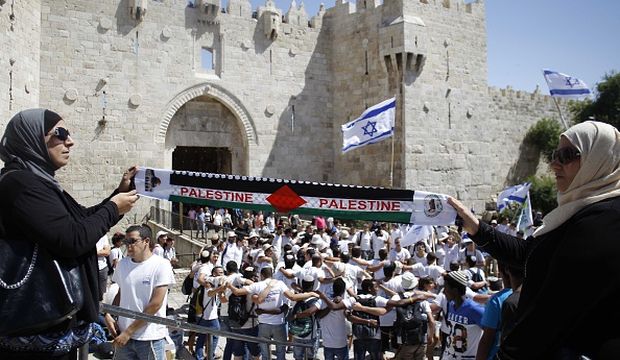[inset_left]Destinies: Concerto of the Holocaust and NakbaRabee Al-MadhounArab Institute for Publication, 267 pagesBeirut, 2015[/inset_left]
London, Asharq Al-Awsat—The subtitle of this new novel by Palestinian writer Rabee Al-Madhoun describes it as “a concerto in four movements.” However, the reader would soon conclude that what Madhoun is offering is more of a symphony woven around the themes of individual and collective destinies, love and hate, and the utter randomness of events that affect our lives while we have little or no control over them.
Composed like a prose version of the Russian Matryushka dolls, with the smaller dolls nesting in the larger ones, the novel narrates the stories of four characters that, at first glance, have as much in common as strange ships passing at night and in fog.
First, there is Ivana Ardakian, an Armenian–Palestinian who comes of age during the British mandate in Palestine. Breaking rigid local traditions she elopes with a British medical doctor and has a daughter from him before they flee to Britain at the end of the British presence. We don’t know whether Ivana’s Armenian family name, which means “a fragile plant,” contains a symbolic message. But her life certainly symbolizes the fragility of the human condition.
In a sense, Ivana’s story could be seen as a long monody of loss, longing and, mercifully, also love.
In a point–counterpoint style Ivana’s story is then related to Jenin Dahman’s narrative in what could be regarded as the second movement of the symphonic expose.
Jenin Dahman, who may sound to some as an alter ego for the writer, is writing a novel of her own with the provocative title of “Stupid Palestinian” (Falastini Tais). This is designed to tell the story of one Mahmoud Dahman who flees with his family from Ashkelon to Gaza during the 1948 convulsion that led to the emergence of Israel as a nation, the event known to Arabs as the Nakba (Catastrophe). For murky reasons, partly related to fear of being arrested by the dreadful Egyptian secret police, Dahman abandons his family in Gaza and moves back to Ashkelon (Al-Majdal in Arabic).
What Dahman had hoped would be a brief sojourn turns out to become a life sentence when he finds out that a ceasefire-line between Israel and Gaza, now under Egyptian rule, would not allow him to be reunited with his family.
Discovering reserves of stoicism in himself, Dahman marries another woman and settles in Israel as if embarking on a strange ship heading for unknown shores.
While telling Dahman’s story, Jenin’s narrator bifurcates into telling the story of her own love affair with Bassem, a West bank Palestinian who has emigrated to the United States. Here, we are dealing with triple exiles creating chasms that only love might bridge.
The loving couple settles in Jaffa, now a suburb of Tel Aviv, and settle in an old castle, maybe hoping to capture some of a past that they never knew but still hope to see as their future.
In the third movement, the direction of exile changes. This time we see Ivana’s daughter Jolie returning to Israel with her husband Walid Dahman to fulfil her mother’s wish for her ashes to be taken to either her native city Acre or Jerusalem. The two visitors, who now lack any personal attachment to the disputed land, visit Haifa, Acre, Jaffa, Jerusalem, and Ashkelon as foreign tourists. Because they see the place with fresh eyes, not affected by two generations of conflict and hatred, they are able to fall in love with the country, regardless. They plan to move to Israel and start a new life which they have no means of predefining.
In the fourth and final movement of the symphony we are again back to a prolonged monody, woven around Walid’s visit to Jerusalem where he spends some time in Yad Vashem, the Holocaust Museum, which provides a glimpse of the tragedy that struck the European Jews under the Nazi domination of 1932–1945. The couple meet Jenin, the struggling novelist in Jaffa, where she reveals to them the sources of her novel and the fate of her characters, providing an unexpected denouement.
Madhoun does not wish to equate the Holocaust with the Nakba; such an attempt would have been rather kitsch. What he is trying to do is understand the collective tragedies through their effect on reshaping, and sometime destroying, individual lives. A proverb says that one may not see the forest for the trees. The moral of it is that focusing on individual realities may make us lose sight of the broader reality.
Madhoun believes that we cannot really see the forest, the real forest, except by seeing the individual trees.
If not related to and understood through individual human narratives, both the Holocaust and the Nakba are little more than abstractions. As collective concepts, Israel and Palestine are shibboleths in political, nationalistic and even pseudo-religious wars, the ultimate aim of which is power. But when we see countless individual human beings with their memories, aspirations, fears and hopes and capacity for both hatred and love, covered by those concepts we realize that only going from the particular to the general may help us understand the so-called “big picture.”
This, of course, is the principal task of literature, especially of the novel in its modern version as developed in Europe from the 19th century onwards.
Those who read Madhoun’s previous novel The Lady from Tel Aviv had no difficult seeing him as a promising novelist. In this second novel, Madhoun delivers on part of that promise with more deft characterization, a fast-paced, almost Hemingway-esque prose, and greater control of rebellious passions.
It would now be worth waiting for his next novel.
